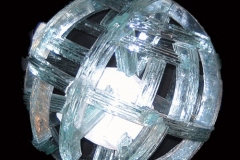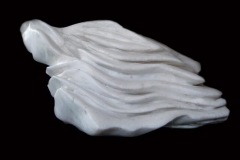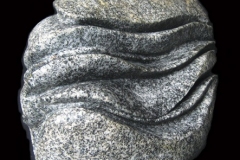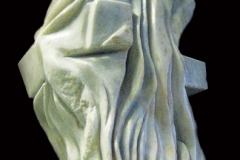Sculpture and nature, in the open space museum.
In the gallery we will find a strong connection between sculpture and nature. Semi di scultura 2°- Nuvole di Pietra is an exposition mainly focused on the impressive work, realized in 2012 and 2013 by Maurizio del Piano. Now his pieces of art are kept in Carrara, Italy, at the Museo Civico of Marble. The reason why he decided to exhibit his work in Carrara is because the marble is unquestionably the protagonist of his work. This is a sort of tribute to the marble. The extraordinary hunch of the artist to join the marble with other materials. From glass to wood. From resin to water. From darkness to light. Maurizio del Piano gives life to a successful contrast which emphasizes marble in all its forms. Maurizio del Piano started this ambitious work with the intention to establish a connection between marble, which symbolises nature in its constituent reality, and sculpture, symbol of the human touch. But his work express much more. It has been a laudable effort to retrace the importance of marble in Italian art. His pieces of art are the evidence that contrasts can coexist and give life to an authentic masterpiece of modern art. Maurizio del Piano creates a dialogue among nature, with the raw material, and the man, characterized by human ingenuity. Maurizio del Piano is constantly looking for lightness. This could be interpreted like a sort of rejection of the industrial revolution which is in continuous expansion, strangling us with its electric cables. With Maurizio del Piano we have a genuine return to nature. To fully understand the importance of sculpture for Maurizio del Piano, we should talk about another fondamental event for the artist, which is the exhibition of his work in the Museo Archeologico Nazionale of Cividate Camuno. This museum (in Val Camonica, Brescia) collects archaeological remnants from the Roman Empire. Maurizio del Piano wants to offer to the audience the encounter between past and present. A meeting among contrasts. Not to be missed is the juxtaposition of the sculpture Sospiri (1913, now situated in Carrara) and the impressive scultura virile of a naked hero in marble of Vezza d’Oglio (Brescia) from the age of Giulio Claudia ( I-II century d.C.). In this piece of art the artist reproduced the smoothness and the virility of the roman statue.
Luciano Caramel




